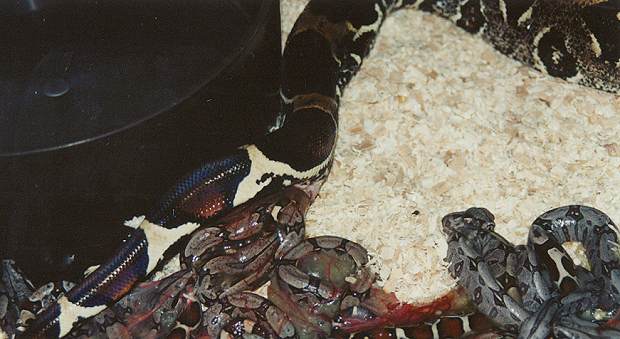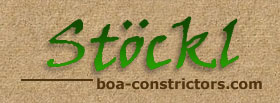Birth of Boas
In boas, birth occurs according to the motto, “what you see is what you get”. There is no guessing of whether the egg is still good, fertile, or if the young inside is still alive, as is the case with the egg-laying pythons.
Neonate boas are born in an elastic, transparent egg sheath, which they need to penetrate. At that point, nature already makes its first choice: Weak animals do not make it and die.
However, we have observed numerous times how mother boas use their mouth after birth to stimulate their young to become active, and even tear the egg sheath to help the young. Should you be lucky enough to observe the process of giving birth, you may do this for the boa mother, if she fails to do so. Of course, you may also decide to be tough and let only the strong ones live.
Caution is necessary, should you do it yourself, as the boa mother is not exactly friendly during and immediately after birth.
Infertile eggs, so-called slugs, are also passed during birth. In the worst case, none of the eggs was fertile and you receive a delivery of 100% slugs (every breeder’s nightmare).
 Birth of Boa c. constrictor (Suriname)
Birth of Boa c. constrictor (Suriname)
First Care for Newborn Boa constrictor babies
In the wild, newborn boas are entirely dependent on themselves from the start, leaving the protective care of the mother within a few hours. Healthy and strong animals shed their skin within 14 days following birth, and start feeding on their own after doing so.
Boa constrictor breeding information | Boa constrictor mating | Boa constrictor reproduction information | Boa constrictor gravidity | how to determine the sex of a Boa constricor | how to tell the sex of a boa | Boa constrictor probing | ovulation | sexual maturity | breeding season | how to tell if my boa is gravid | Boa constrictor giving birth | gestation period | brumation
Besides the necessary cleanup in the enclosure, no further measures are theoretically required. However, providing the neonate boas with a first care has a number of advantages. The first care consists of the following:
- Drying the boa baby with a paper towel from the residues of birth
- Tying of the umbilical cord with a thick threat or dental string two fingers in width from the stomach
- Cutting the umbilical cord below the tied part with a sterilized pair of scissors
- Quick bathing of the animal in lukewarm water to wash off sticky remains of the birth process
- Drying the boa baby with a paper towel
- Powdering the umbilical cord with a wound powder available at pharmacies
- Placing the animal inside a freshly cleaned enclosure with kitchen paper as substrate
- Repeat powdering of the umbilical cord again the following day
This handling immediately following birth gets the animal used to the person, which will thereby lose most of its aggressiveness. In addition, taking care of the umbilical cord prevents any potential infections.
The yolk sac, to which the neonate boas are connected through the umbilical cord, is completely exhausted in normally developed young at the time of birth. However, often times there are also some neonates in a given litter that “would have needed a few more days”. These animals are still attached to a more or less large-sized yolk sac.
At this point, it would be wrong to cut the umbilical cord the way it was described earlier. Instead, try to place the animal with the yolk sac inside of a plastic container that is lined with moist kitchen paper. Then place the plastic container inside of a warm enclosure. With a little bit of luck, the early bird will absorb a good bit of the remaining yolk, and thereby become just as strong and healthy as its well-developed siblings.
One more tip for people acquiring neonate boas: The approximately 1.5 cm (~0.6 inches) long lengthwise cut on the stomach of the animals is normal. This is from the umbilical cord that was positioned at that spot, and disappears in time.
